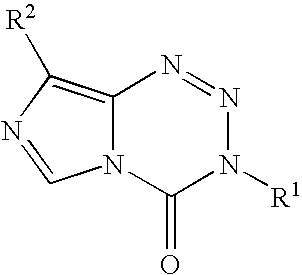Concurrent chemotherapy and immunotherapy
a technology of immunotherapy and chemotherapy, applied in the field of cancer immunotherapy, can solve the problems of few clinical efficacy demonstrations, reluctance to treat gbm patients with some form of chemotherapy, and systemic or neurological dose limitation,
- Summary
- Abstract
- Description
- Claims
- Application Information
AI Technical Summary
Problems solved by technology
Method used
Image
Examples
example 1
[0041]To test the hypothesis that chemotherapy and immunotherapy can be administered concurrently, we treated a patient with a newly diagnosed GBM using the standard of care, temozolomide, while also administering a peptide vaccine targeting the epidermal growth factor variant III (EGFRvIII) (Heimberger et al., 2006). The amplification of the epidermal growth factor receptor (EGFR) gene, which results in over expression of the EGFR, a transmembrane tyrosine kinase receptor (Ekstrand et al., 1991) is associated with the mutant EGFR gene, EGFRvIII (Wikstrand et al., 1997). Previous work has shown that EGFR amplification is evident in all GBMs expressing EGFRvIII (Heimberger et al., 2005) and GBMs lacking the amplified EGFR are not positive for EGFRvIII protein (Aldape et al., 2004).
[0042]In May of 2005, a 51-year-old Caucasian man was evaluated following complaints of a three-week history of persistent morning headaches without associated nausea. A magnetic resonance (MR) image reveal...
example 2
[0044]Delayed type hypersensitivity (DTH) testing to common recall antigens and the components of the vaccine were evaluated prior to the start of the vaccines, after the 3rd vaccine and monthly during his maintenance cycle on day 26. Prior to the start of the vaccine and after the completion of radiation and concurrent temozolomide the patient was only reactive to Candida and had no DTH reaction to the components of the vaccine, PEPvIII or KLH. However, after the 3rd vaccination, the patient became responsive to the KLH component of the vaccine. After the 10th vaccination, and while receiving concurrent temozolomide, he became reactive to the PEPvIII component of the vaccine. For comparison, of the patients that received the vaccine without cycled temozolomide (n=22), less than 15% ever became reactive to the PEPvIII component. After the most recent follow-up and administration of the 14th vaccination, the patient was markedly indurated (16×15 mm) at the PEPvIII DTH site. This woul...
example 3
[0045]To determine if PEPvIII-specific humoral responses were induced, serum was obtained from the patient monthly and was stored at −20° C. before analysis in a PEPvIII-Dynabead® assay. PEPvIII or the extracellular domain of EGFRvIII (EGFRvIII-ECD) were covalently linked to magnetic microspheres that were used to capture specific antibodies from patient's serum (Invitrogen, Carlsbad, Calif.) according to the manufacturer's instructions. All serum samples are initially diluted 1:10 with phosphate-buffered saline (PBS)+0.5% bovine serum albumin (BSA) and assayed in triplicate. To determine specificity, an additional sample set was pre-incubated for 15 minutes with 500 ng of the PEPvIII peptide to block any anti-PEPvIII that would be captured by the PEPvIII conjugated Dynabeads. Standards of human-mouse chimeric anti-PEPvIII antibody (81-0.11 ng / ml) are run with each assay along with positive (patient sample ACT4) and negative (normal donor serum) controls. The flow cytometer was stan...
PUM
| Property | Measurement | Unit |
|---|---|---|
| median survival time | aaaaa | aaaaa |
| area | aaaaa | aaaaa |
| length | aaaaa | aaaaa |
Abstract
Description
Claims
Application Information
 Login to View More
Login to View More - R&D
- Intellectual Property
- Life Sciences
- Materials
- Tech Scout
- Unparalleled Data Quality
- Higher Quality Content
- 60% Fewer Hallucinations
Browse by: Latest US Patents, China's latest patents, Technical Efficacy Thesaurus, Application Domain, Technology Topic, Popular Technical Reports.
© 2025 PatSnap. All rights reserved.Legal|Privacy policy|Modern Slavery Act Transparency Statement|Sitemap|About US| Contact US: help@patsnap.com

